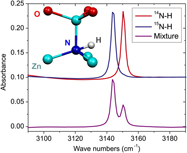Crossref Citations
This article has been cited by the following publications. This list is generated based on data provided by
Crossref.
Bala, Waclaw
Zorenko, Yurij
Savchyn, Volodymyr
Voznyak, Taras
Paprocki, Kazimierz
Popielarski, Pawel
and
Szybowicz, Miroslaw
2013.
Optical and Electrical Properties of ZnO Thin Films Grown by Sol-Gel Method.
Solid State Phenomena,
Vol. 200,
Issue. ,
p.
14.
Stavola, Michael
Bekisli, Figen
Yin, Weikai
Smithe, Kirby
Beall Fowler, W.
and
Boatner, Lynn A.
2014.
Contrasting the experimental properties of hydrogen in SnO2, In2O3, and TiO2.
Journal of Applied Physics,
Vol. 115,
Issue. 1,
Li, H.
and
Robertson, J.
2014.
Behaviour of hydrogen in wide band gap oxides.
Journal of Applied Physics,
Vol. 115,
Issue. 20,
Baraki, Raschid
Zierep, Paul
Erdem, Emre
Weber, Stefan
and
Granzow, Torsten
2014.
Electron paramagnetic resonance study of ZnO varistor material.
Journal of Physics: Condensed Matter,
Vol. 26,
Issue. 11,
p.
115801.
Gardés, Emmanuel
Gaillard, Fabrice
and
Tarits, Pascal
2014.
Toward a unified hydrous olivine electrical conductivity law.
Geochemistry, Geophysics, Geosystems,
Vol. 15,
Issue. 12,
p.
4984.
Lee, Ha Rim
Lee, Su Woong
Kang, Jung Su
Hong, Ji Hwan
Callixte, Shikili
Park, Hee Tae
Kim, Won Jong
and
Park, Kyu Chang
2014.
Cathodoluminescence properties of ZnO thin films with the carbon nanotube emitters beam (C-beam) exposure.
p.
184.
Vilão, R. C.
Vieira, R. B. L.
Alberto, H. V.
Gil, J. M.
Weidinger, A.
Lichti, R. L.
Baker, B. B.
Mengyan, P. W.
and
Lord, J. S.
2015.
Muonium donor in rutileTiO2and comparison with hydrogen.
Physical Review B,
Vol. 92,
Issue. 8,
Yin, Weikai
Smithe, Kirby
Weiser, Philip
Stavola, Michael
Fowler, W. Beall
Boatner, Lynn
Pearton, Stephen J.
Hays, David C.
and
Koch, Sandro G.
2015.
Hydrogen centers and the conductivity ofIn2O3single crystals.
Physical Review B,
Vol. 91,
Issue. 7,
Bivour, Martin
Temmler, Jan
Steinkemper, Heiko
and
Hermle, Martin
2015.
Molybdenum and tungsten oxide: High work function wide band gap contact materials for hole selective contacts of silicon solar cells.
Solar Energy Materials and Solar Cells,
Vol. 142,
Issue. ,
p.
34.
Schultz, Andrew M.
Brown, Thomas D.
and
Ohodnicki, Paul R.
2015.
Optical and Chemi-Resistive Sensing in Extreme Environments: La-Doped SrTiO3 Films for Hydrogen Sensing at High Temperatures.
The Journal of Physical Chemistry C,
Vol. 119,
Issue. 11,
p.
6211.
McCluskey, Matthew D.
2015.
Defects in Semiconductors.
Vol. 91,
Issue. ,
p.
279.
Dargatz, Benjamin
Gonzalez-Julian, Jesus
Bram, Martin
Jakes, Peter
Besmehn, Astrid
Schade, Lisa
Röder, Robert
Ronning, Carsten
and
Guillon, Olivier
2016.
FAST/SPS sintering of nanocrystalline zinc oxide—Part I: Enhanced densification and formation of hydrogen-related defects in presence of adsorbed water.
Journal of the European Ceramic Society,
Vol. 36,
Issue. 5,
p.
1207.
Weiser, Philip
Qin, Ying
Yin, Weikai
Stavola, Michael
Fowler, W. Beall
and
Boatner, Lynn A.
2016.
Symmetry and diffusivity of the interstitial hydrogen shallow-donor center in In2O3.
Applied Physics Letters,
Vol. 109,
Issue. 20,
Gupta, Sushant
Singh, Fouran
Gangrade, M.
Sulania, I.
and
Das, B.
2016.
WITHDRAWN: Role of carrier concentration in swift heavy ion irradiation induced surface modifications.
Applied Surface Science,
Zheng, Mindong
Ni, Jiamiao
Liang, Fei
Wang, Moo-Chin
and
Zhao, Xiujian
2016.
Effect of annealing temperature on the crystalline structure, growth behaviour and properties of SnO2:Sb thin films prepared by radio frequency (RF)-magnetron sputtering.
Journal of Alloys and Compounds,
Vol. 663,
Issue. ,
p.
371.
El Hat, Abderrahim
Rouchdi, Mustapha
Hadri, Adil
Nassiri, Chourouk
Chafi, Fatima Zahra
Fares, Boubker
Laanab, Larbi
Hassanain, Najem
Labrim, Hicham
and
Mzerd, Ahmed
2016.
Effects of sulfur concentration on structural, optical and electrical properties of Tin Oxide thin films deposited by spray pyrolysis technique.
p.
195.
da Silva, E. Lora
Marinopoulos, A. G.
Vieira, R. B. L.
Vilão, R. C.
Alberto, H. V.
Gil, J. M.
Lichti, R. L.
Mengyan, P. W.
and
Baker, B. B.
2016.
Electronic structure of interstitial hydrogen in lutetium oxide fromDFT+Ucalculations and comparison study withμSRspectroscopy.
Physical Review B,
Vol. 94,
Issue. 1,
Idígoras, Jesús
Anta, Juan A.
and
Berger, Thomas
2016.
Charge-Transfer Reductive in Situ Doping of Mesoporous TiO2 Photoelectrodes: Impact of Electrolyte Composition and Film Morphology.
The Journal of Physical Chemistry C,
Vol. 120,
Issue. 49,
p.
27882.
Yin, Weikai
Qin, Ying
Fowler, W Beall
Stavola, Michael
and
Boatner, Lynn A
2016.
The structures of interstitial hydrogen centers in VO2in the dilute limit from their vibrational properties and theory.
Journal of Physics: Condensed Matter,
Vol. 28,
Issue. 39,
p.
395401.
Zhang, Zhen
and
Yates, John T.
2016.
A new form of chemisorbed photo- and electro-active atomic H species on the TiO2(110) surface.
Surface Science,
Vol. 652,
Issue. ,
p.
195.
